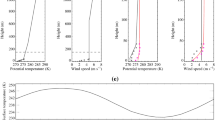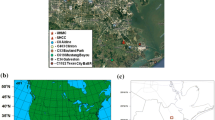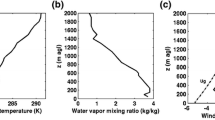Abstract
A large-eddy simulation (LES) model has been used to study a nocturnalstratocumulus-topped marine atmospheric boundary layer. The main objectivesof our study have been first to investigate the statistical significance of LES-derived data products. Second, to test the sensitivity of our LES results with respect to the representation of subgrid-scale mixing and microphysical processes, and third to evaluate and to quantify the parametric uncertainty arising from the incomplete knowledge of the environmental parameters that are required to specify the initial and boundary conditions of a particular case study. Model simulations were compared with observations obtained in solid stratocumulus during the third flight of the first 'Lagrangian' experiment of the Atlantic Stratocumulus Transition Experiment (ASTEX). Based on these simulations the following conclusions could be drawn. Resolution(50 × 50 × 25 m3) and domain size (3.2 × 3.2 × 1.5 km3) of the LES calculations were adequate from a numerical point of view to represent the essential features of the stratocumulus-topped boundary layer. However, the ensemble runs performed in our study to investigate the statistical significance of LES-derived data products demonstrate that the area-time averaging procedure for the second-order moments produces only a low degree of statistical reliability in the model results. This illustratesthe necessity of having LES model results that are not only of adequate resolution but also of sufficiently large domain. The impact of different subgrid schemes was small, but the primary effects of drizzle were found to influence the boundary-layer structure in a climatologically significant way. The parametric uncertainty analysis revealed that the largest contribution to the variance of the LES-derived data products is due to theuncertainties in the cloud-top jump of total water mixing ratio and the net radiative forcing. The differences between the model and measurements for most of the simulated quantities were within the modelling uncertainties, but the calculated precipitation rate was found to differ significantly from that derived in the observations.
Similar content being viewed by others
References
Andren, A.: 1995, 'The Structure of Stably Stratified Atmospheric Boundary Layers: A Large-Eddy Simulation Study', Quart. J. Roy. Meteorol. Soc. 121, 961-985.
Blackadar, A. K.: 1957, 'Boundary Layer Wind Maxima and their Significance for the Growth of Nocturnal Inversions', Bull. Amer. Meteorol. Soc. 38, 283-290.
Bridges, T. J. and Morris, P. J.: 1984, 'Differential Eigenvalue Problems in which the Parameter Appears Nonlinearly', J. Comp. Phys. 55, 437-460.
Brost, R. A. and Wyngaard, J. C.: 1978, 'A Model Study of the Stably Stratified Planetary Boundary Layer', J. Atmos. Sci. 35, 1427-1440.
Brown, A. R., Derbyshire, S. H., and Mason, P. J.: 1994, 'Large-Eddy Simulation of Stable Atmospheric Boundary Layers with a Revised Stochastic Subgrid Model', Quart. J. Roy. Meteorol. Soc. 120, 1485-1512.
Businger, J. A., Wyngaard, J. C., Izumi, Y., and Bradley, E. F.: 1971, 'Flux-Profile Relationships in the Atmospheric Surface Layer', J. Atmos. Sci. 28, 181-189.
Carruthers, D. J. and Moeng, C.-H.: 1987, 'Waves in the Overlying Inversion of the Convective Boundary Layer', J. Atmos. Sci. 44, 1801-1808.
Coleman, G. N., Ferziger, J. H., and Spalart, P. R.: 1992, 'Direct Simulation of the Stably Stratified Turbulent Ekman Layer', J. Fluid Mech. 244, 677-712.
Deardorff, J. W.: 1980, 'Stratocumulus-Capped Mixed Layers Derived from a Three-Dimensional Model', Boundary-Layer Meteorol. 18, 495-527.
Delage, Y.: 1974, 'A Numerical Study of the Nocturnal Atmospheric Boundary Layer', Quart. J. Roy. Meteorol. Soc. 100, 351-364.
Derbyshire, S. H.: 1990, 'Nieuwstadt's Stable Boundary Layer Revisited', Quart. J. Roy. Meteorol. Soc. 116, 127-158.
Derbyshire, S. H.: 1995, 'Stable Boundary Layers: Observations, Models and Variability. Part I: Modelling and Measurements', Boundary-Layer Meteorol. 74, 19-54.
Finnigan, J. J., Einaudi, E., and Fua, D.: 1984, 'The Interaction between an Internal Gravity Wave and Turbulence in the Stably-Stratified Nocturnal Boundary Layer', J. Atmos. Sci. 41, 2409-2436.
Galmarini, S., Beets, C., Duynkerke, P. G., and Vilã-Guerau de Arellano, J.: 1988, 'Stable Nocturnal Boundary Layers: A Comparison of One-Dimensional and Large-Eddy Simulation Models', Boundary-Layer Meteorol. 88, 181-210.
Gossard, E. E. and Hooke, W. H.: 1975, Waves in the Atmosphere, Elsevier Scientific Publishing Company, Amsterdam, 456 pp.
Hazel, P.: 1972, 'Numerical Studies of the Stability of Inviscid Stratified Shear Flows', J. Fluid Mech. 51, 39-61.
Hunt, J. C. R., Kaimal, J. C., and Gaynor, J. E.: 1985, 'Some Observations of Turbulence Structure in Stable Layers', Quart. J. Roy. Meteorol. Soc. 111, 783-815.
Klemp, J. B. and Durran, D. R.: 1983, 'An Upper Boundary Condition Permitting Internal Gravity Wave Radiation in Numerical Mesoscale Models', Mon. Wea. Rev. 111, 430-444.
Kosovic, B. and Curry, J. A.: 2000, 'A Large-Eddy Simulation Study of a Quasi-Steady Stably-Stratified Atmospheric Boundary Layer', J. Atmos. Sci., in press.
Lin, C.-L., McWilliams, J. W., Moeng, C.-H., and Sullivan, P. P.: 1996, 'Coherent Structures and Dynamics in a Neutrally Stratified Planetary Boundary Layer Flow', Phys. Fluids 8, 2626-2639.
Mahrt, L.: 1998, 'Stratified Atmospheric Boundary Layers and Breakdown of Models', Theor. Comp. Fluid Dyn. 11, 263-280.
Mason, P. J. and Derbyshire, S. H.: 1990, 'Large-Eddy Simulation of the Stably-Stratified Atmospheric Boundary Layer', Boundary-Layer Meteorol. 53, 117-162.
Moeng, C.-H.: 1984, 'A Large-Eddy-Simulation Model for the Study of Planetary Boundary-Layer Turbulence', J. Atmos. Sci. 2052-2062.
Moeng, C.-H. and Sullivan, P. P.: 1994, 'A Comparison of Shear-and Buoyancy-Driven Planetary Boundary Layer Flows', J. Atmos. Sci. 51, 999-1022.
Nieuwstadt, F. T. M.: 1984, 'The Turbulent Structure of the Stable, Nocturnal Boundary Layer', J. Atmos. Sci. 41, 2202-2216.
Stull, R. B.: 1988, An Introduction to Boundary Layer Meteorology, Kluwer Academic Publishers, Dordrecht, 666 pp.
Sullivan, P. P., McWilliams, J. C., and Moeng, C.-H.: 1994, 'A Subgrid-Scale Model for Large-Eddy Simulation of Planetary Boundary-Layer Flows', Boundary-Layer Meteorol. 71, 247-276.
Sullivan, P. P., McWilliams, J. C., and Moeng, C.-H.: 1996, 'A Grid Nesting Method for Large-Eddy Simulation of Planetary Boundary-Layer Flows', Boundary-Layer Meteorol. 80, 167-202.
Author information
Authors and Affiliations
Rights and permissions
About this article
Cite this article
Chlond, A., Wolkau, A. Large-Eddy Simulation Of A Nocturnal Stratocumulus-Topped Marine Atmospheric Boundary Layer: An Uncertainty Analysis. Boundary-Layer Meteorology 95, 31–55 (2000). https://doi.org/10.1023/A:1002438701638
Issue Date:
DOI: https://doi.org/10.1023/A:1002438701638




